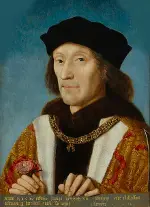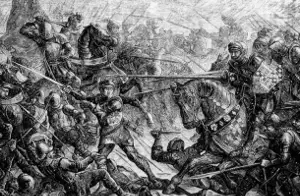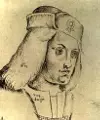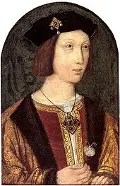King Henry VII of England
Henry VII was King of England in the late 15th Century and early 16th Century. The first monarch of the House of Tudor, he is perhaps most well-known for defeating Richard III at Bosworth Field, ending the Wars of the Roses, and for being the father of King Henry VIII. 
He was born on Jan. 28, 1457, at Pembroke Castle. His father, Edmund Tudor, died before young Henry was born. Henry's mother was Margaret Beaufort, and it was through her that he could place some claim to the throne of England. A grandfather of Henry was Owen Tudor, founder of the Tudor dynasty. A Welshman by birth, he was a squire to King Henry V and, after the king died, married his widow, Catherine of Valois. Their son Edmund, the Earl of Richmond, married Margaret Beaufort, who claimed Edward III's third son, John of Gaunt, as her ancestor. John's son Henry became King Henry IV, his son Henry became King Henry V, and his son Henry became King Henry VI. The monarch when Henry Tudor was born was Henry VI, who had lost the Hundred Years War and had been the leader of the House of Lancaster, one of the two sides in the internecine strife known as the Wars of the Roses. Both sides (the House of York being the other) had claimed legitimacy through lineage extending to King Edward III. 
The House of York was in the ascendancy in 1461, led by Edward, who was crowned King Edward IV in that year. Each side claimed a number of victories, many of them particularly bloody and gruesome, for the next two decades. During this time, Henry Tudor was growing up. His mother was just 13 when he was born. Edmund's brother Jasper Tudor was an early father figure for the boy. Yorkist forces seized Pembroke Castle and captured young Henry when he was just 4. Not much is known of the next few years of his life, other than that he lived with his uncle Jasper in Brittany. Henry re-entered the fray in 1483, after the death of Edward IV, the disappearance of Edward's son and heir, and the ascension as king of Richard III. Jasper Tudor had been a commander in the Lancastrian army in the intervening years and, after the announcement of Richard as king, had set about planning an invasion from Brittany, an independent duchy in which he had been living. Henry, then 26, joined the invasion, but a chance storm in the English Channel wrecked the invasion fleet and Henry fled to the Continent. Richard arranged for the local authorities to capture Henry and hand him over, but Henry escaped just in time and went to France proper. 
The Wars of the Roses were technically ongoing at this time. Richard was the standard-bearer of the House of York, and the House of Lancaster still had considerable manpower and ammunition. The pace of war had stagnated, but the Lancastrians still burned with a passion for ousting Richard from the throne. Henry returned from the Continent, landing this time in Wales, in August of 1485. He found support for his claim to the throne and acted as the nominal head of the House of Lancaster. He led those forces into battle at Bosworth Field, where, on August 22, the Lancastrians were victorious and Richard was killed. Henry claimed the kingship and was crowned on October 30 at Westminster Abbey. He summoned Parliament, which met a week later and ordained his kingship. The victory at Bosworth Field had essentially ended the civil war. Henry sought to heal some of the wounds by marrying Elizabeth of York, the oldest daughter of Edward IV. The royal wedding took place on Jan. 18, 1486. They had seven children in all; only four of them survived into adulthood. The oldest Henry also sought to symbolically meld the warring houses together, styling a new rose that combined the Lancaster red rose and the York white rose. The result was the Tudor rose. 
Henry took the throne at a time when the royal treasury was considerably lighter than it had been in a long time, primarily because of the ongoing conflicts. He set about restoring the coffer levels while at the same time restoring faith in the monarchy. The back-and-forth claiming and reclaiming of the throne by Henry VI and then Edward IV and then Richard had made many people suspicious of the king, and the three decades of fighting had killed tens of thousands of people and made the survivors weary and, in many cases, destitute. Henry managed to coax taxes out of much of the populace while also increasing customs yields and the amount received from the payment of royal fines. English revenues from trade increased dramatically under Henry's reign particularly in exchange for alum, a chemical fixative used in the production of cotton and wool. He also made trade deals with Denmark and Florence, for fishing rights and the wool trade, respectively. In fact, Henry left a rejuvenated and healthy treasury to his son and successor, Henry VIII. One main way that Henry kept the domestic peace was in largely keeping the status quo in terms of officials running the government. Another way that he kept the peace was passing laws that prevented nobles from keeping their own independent armies, the existence of which had contributed to many rebellions in years past. The Wars of the Roses had considerably reduced the ranks of the nobility, so Henry did not have to face the kind of uprising potential as had some of his predecessors. However, he did have to put down a few rebellion attempts during his reign. One was in support of a boy named Lambert Simnel, who claimed to be the son of George, Edward IV's brother. This would have made him the senior surviving members of the Yorkists. A powerful noble in Ireland declared the boy king and the Earl of Lincoln headed up an invasion of England, which Henry's forces defeated at the Battle of Stoke Field; rather than resort to a series of summary executions, Henry pardoned the Irish noble and assigned the boy, who as all of 10, to be a servant in the royal kitchen. Young Lambert then largely disappeared from history. 
The most significant rebellion was that of Perkin Warbeck, who claimed to be Richard the long-lost son of Edward IV, whose disappearance from the Tower of London after Edward's death, along with that of the intended Edward V, had sparked a round of suspicion that caused many people to accuse Richard III of killing his nephews. Warbeck tried three times to gather the remnants of the Yorkist sympathizers into some kind of fighting force, but none of those attempts succeeded. One of Warbeck's invasion attempts was from Scotland, whose king, James IV, sought to destabilize England and led a force southward in 1496. Henry succeeded in pacifying James by offering his own daughter, Margaret, in marriage. James accepted, and this union eventually led to the union of the monarchies of the two countries (in the person of King James VI of Scotland, who became King James I of England. Warbeck, meanwhile, was captured in 1497 and executed. Henry also succeeded in making peace with most of his European counterparts. His marrying his son Arthur to Catherine of Aragon was part of the Treaty of Medina del Campo, a peace deal between England and the newly unified Spanish kingdom ruled by King Ferdinand and Queen Isabella (whose daughter Catherine was). Henry agreed to the Treaty of Perpetual Peace with Scotland, the first time that the two nations had come to such terms in nearly 200 years. Henry made a friend of the Holy Roman Emperor, who at the time was Maximilian I. 
Henry's oldest son, Arthur, died in 1502 of a mystery illness that was then described as the "English sweating sickness." Arthur's death left his wife a widow and his younger brother, Henry, the heir apparent. After a period of intense grief resulting from the death of his son Arthur, Henry procured from Pope Julius II a papal dispensation allowing his son Henry to marry Arthur's widow, Catherine. Henry's queen, Elizabeth, died in childbirth in 1503, and Henry suffered another round of intense grief. He cast about for another marriage candidate but never found one. He largely retired from public life, spending time with the rest of his family, including his mother who was still alive. Another reason that Henry spent much time out of the public eye was that he had contracted tuberculosis. He died of this, on April 21, 1509. His son became King Henry VIII. |
|
Social Studies for Kids
copyright 2002–2024
David White



 was Arthur, who married Catherine of Aragon but died relatively young. The second son was Henry, who became King Henry VIII. The daughters were Margaret and Mary.
was Arthur, who married Catherine of Aragon but died relatively young. The second son was Henry, who became King Henry VIII. The daughters were Margaret and Mary.
